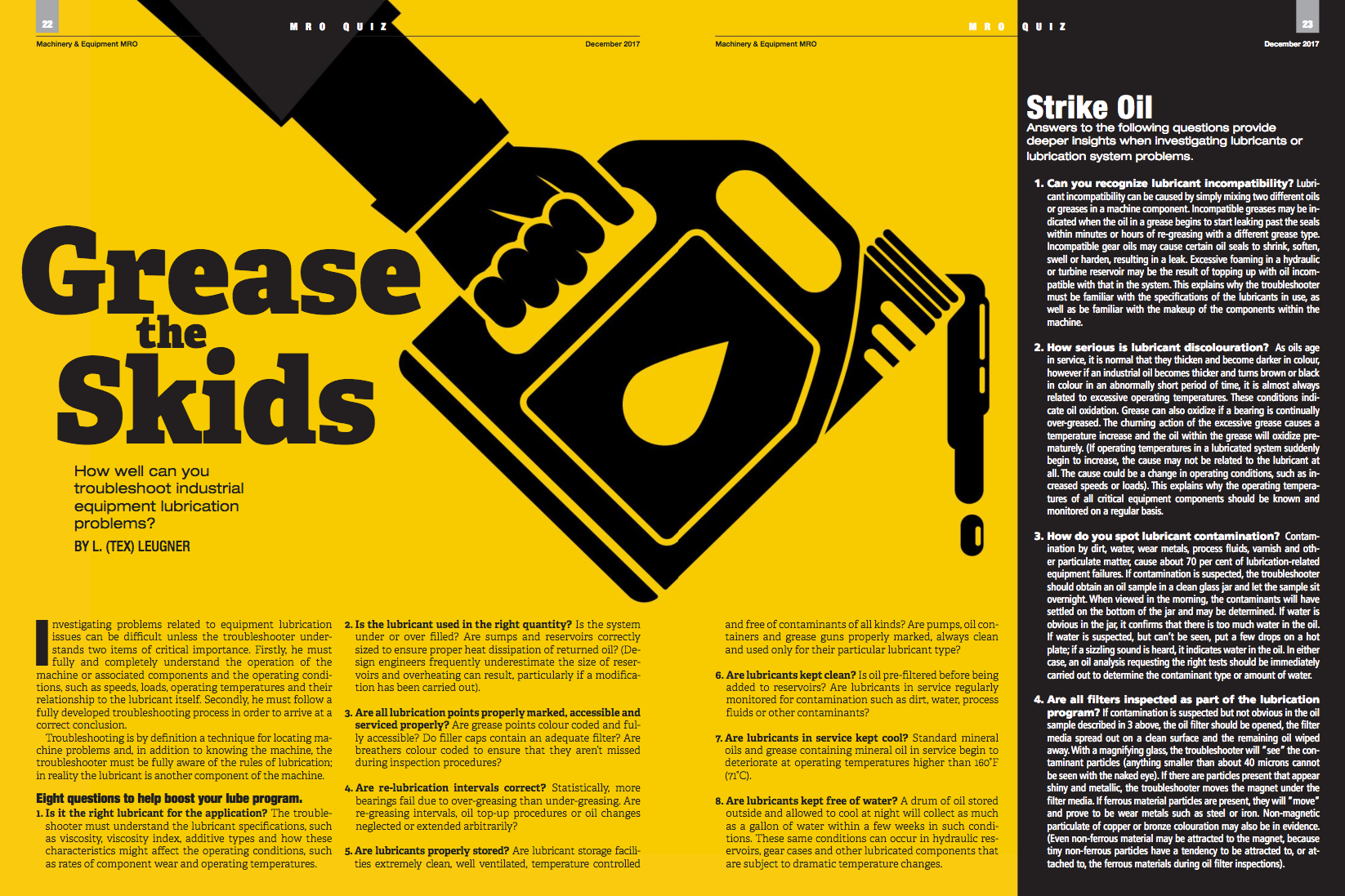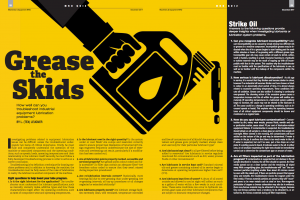
MRO Quiz – How well can you troubleshoot lubrication problems?
December 11, 2017 | By L. (Tex) Leugner


Photo: Getty Images.
Investigating problems related to equipment lubrication issues can be difficult unless the troubleshooter understands two items of critical importance. Firstly, he must fully and completely understand the operation of the machine or associated components and the operating conditions, such as speeds, loads, operating temperatures and their relationship to the lubricant itself. Secondly, he must follow a fully developed troubleshooting process in order to arrive at a correct conclusion.
Troubleshooting is by definition a technique for locating machine problems and, in addition to knowing the machine, the troubleshooter must be fully aware of the rules of lubrication; in reality the lubricant is another component of the machine.
Use the following steps to brush up and improve your lube program.
1. Is it the right lubricant for the application?
Logic: The troubleshooter must understand the lubricant specifications, such as viscosity, viscosity index, additive types and how these characteristics might affect the operating conditions, such as rates of component wear and operating temperatures.
2. Is the lubricant used in the right quantity?
Logic: Is the system under or over filled? Are sumps and reservoirs correctly sized to ensure proper heat dissipation of returned oil? (Design engineers frequently underestimate the size of reservoirs and overheating can result, particularly if a modification has been carried out).
3. Are all lubrication points properly marked, accessible and serviced properly?
Logic: Are grease points colour coded and fully accessible? Do filler caps contain an adequate filter? Are breathers colour coded to ensure that they aren’t missed during inspection procedures?
4. Are re-lubrication intervals correct?
Logic: Statistically, more bearings fail due to over-greasing than under-greasing. Are re-greasing intervals, oil top-up procedures or oil changes neglected or extended arbitrarily?
5. Are lubricants properly stored?
Logic: Are lubricant storage facilities extremely clean, well ventilated, temperature controlled and free of contaminants of all kinds? Are pumps, oil containers and grease guns properly marked, always clean and used only for their particular lubricant type?
6. Are lubricants kept clean?
Logic: Is oil pre-filtered before being added to reservoirs? Are lubricants in service regularly monitored for contamination such as dirt, water, process fluids or other contaminants?
7. Are lubricants in service kept cool?
Logic: Standard mineral oils and grease containing mineral oil in service begin to deteriorate at operating temperatures higher than 160°F (71°C).
8. Are lubricants kept free of water?
Logic: A drum of oil stored outside and allowed to cool at night will collect as much as a gallon of water within a few weeks in such conditions. These same conditions can occur in hydraulic reservoirs, gear cases and other lubricated components that are subject to dramatic temperature changes.
Strike Oil: Answers to the following questions provide deeper insights when investigating lubricants or lubrication system problems.
Can you recognize lubricant incompatibility?
Lubricant incompatibility can be caused by simply mixing two different oils or greases in a machine component. Incompatible greases may be indicated when the oil in a grease begins to start leaking past the seals within minutes or hours of re-greasing with a different grease type. Incompatible gear oils may cause certain oil seals to shrink, soften, swell or harden, resulting in a leak. Excessive foaming in a hydraulic or turbine reservoir may be the result of topping up with oil incompatible with that in the system. This explains why the troubleshooter must be familiar with the specifications of the lubricants in use, as well as be familiar with the makeup of the components within the machine.
How serious is lubricant discolouration?
As oils age in service, it is normal that they thicken and become darker in colour, however if an industrial oil becomes thicker and turns brown or black in colour in an abnormally short period of time, it is almost always related to excessive operating temperatures. These conditions indicate oil oxidation. Grease can also oxidize if a bearing is continually over-greased. The churning action of the excessive grease causes a temperature increase and the oil within the grease will oxidize prematurely. (If operating temperatures in a lubricated system suddenly begin to increase, the cause may not be related to the lubricant at all. The cause could be a change in operating conditions, such as increased speeds or loads). This explains why the operating temperatures of all critical equipment components should be known and monitored on a regular basis.
How do you spot lubricant contamination?
Contamination by dirt, water, wear metals, process fluids, varnish and other particulate matter, cause about 70 per cent of lubrication-related equipment failures. If contamination is suspected, the troubleshooter should obtain an oil sample in a clean glass jar and let the sample sit over night. When viewed in the morning, the contaminants will have settled on the bottom of the jar and may be determined. If water is obvious in the jar, it confirms that there is too much water in the oil. If water is suspected, but can’t be seen, put a few drops on a hot plate; if a sizzling sound is heard, it indicates water in the oil. In either case, an oil analysis requesting the right tests should be immediately carried out to determine the contaminant type or amount of water.
Are all filters inspected as part of the lubrication program?
If contamination is suspected but not obvious in the oil sample described in 3 above, the oil filter should be opened, the filter media spread out on a clean surface and the remaining oil wiped away. With a magnifying glass, the troubleshooter will “see” the contaminant particles (anything smaller than about 40 microns cannot be seen with the naked eye). If there are particles present that appear shiny and metallic, the troubleshooter moves the magnet under the filter media. If ferrous material particles are present, they will “move” and prove to be wear metals such as steel or iron. Non-magnetic particulate of copper or bronze colouration may also be in evidence. (Even non-ferrous material may be attracted to the magnet, because tiny non-ferrous particles have a tendency to be attracted to, or attached to, the ferrous materials during oil filter inspections).
L. (Tex) Leugner, the author of Practical Handbook of Machinery Lubrication, is a 15-year veteran of Royal Canadian Electrical Mechanical Engineers where he served as a Technical Specialist. He was the founder and operations manager of Maintenance Technolgy International Inc. for 30 years. Leugner holds an STLE lubricant specialist certification and is a millwright and heavy duty mechanic. He can be reached at texleug@shaw.ca.
A version of this article appears in the December 2017 issue of Machinery and Equipment MRO.
